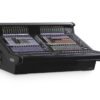DiGiCo S31
DiGiCo S31
It’s a given that with any DiGiCo product, audio quality is of paramount importance; the SD Series is testament to this, be it the rack mount SD11 or the flagship SD7, audio performance comes first. With the introduction of the S Series, DiGiCo used the same principles, developing a smart concept with the same core FPGA engine algorithms and processing, all running at 96kHz, which means no loss in audio quality or functionality.
The S31 is now the bigger version of the S21. The S31’s expanded work surface offers 10 additional faders for more control and two other multi touch screens for faster access and more visual feedback. Ideally suited to applications where more instant control and feedback are critical to the operator.
We at DiGiCo also know that many engineers like to keep their VCAs separate; this is now easily achieved, without compromising your preferred workflow with the option of dedicating a section to your VCA’s. Naturally these faders are in groups of 10, so there’s plenty of space to build a full production: why not layout a whole drum kit on one bank, an entire strings section on the second, and the band on the third? It just makes everything that little bit more accessible.
The S31 still offers the same flexibility as the S21, with 24x Mic inputs and 12x line outputs on the rear of the console, for straightforward audio connection. There are also 2x DMI ports as standard on the console as well as the UB MADI interface for DAW recording. It goes to show that big things do come in small packages.
Under The Hood
Familiar to the touch and built for the road, the S31 offers mixing without limits. The integration of a high power QuadCore SoC with high bandwidth memory, a low power 484-ball array FPGA and a fourth-generation control SHARC DSP offers unprecedented power today as well as the potential for a future processing upgrade path. The compact footprint of the S31 has no relationship to the scale of processing power going on under the polycarbonate worksurface.
Visual feedback is further reinforced by the HTL (Hidden Till Lit) functionality of the encoder rings, while parameters currently not in use are automatically greyed out, always drawing your attention to the right controls.
The triple screens aim to aid the new user learning curve and remove distractions by not only giving you more channels to view at any one time, but also allowing one screen to be used as a setup or master whilst the others are utilised for operation. All touchscreens are responsive to EQ shaping, with fine-tuning available via the tactile and intuitive rotary encoders.
Altering the Channel Bank layout, and mixing and matching any channel, aux, group, control group, or matrix within a bank, is easily accomplished by drag and drop at the touch of a screen.
Más productos DiGiCo
Productos relacionados
Allen & Heath
Allen & Heath
Allen & Heath
Allen & Heath
Allen & Heath
Allen & Heath
Digico
Allen & Heath


















